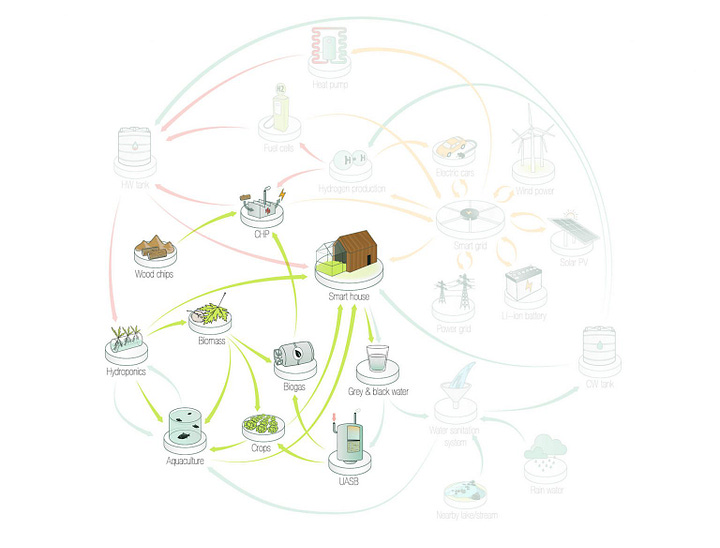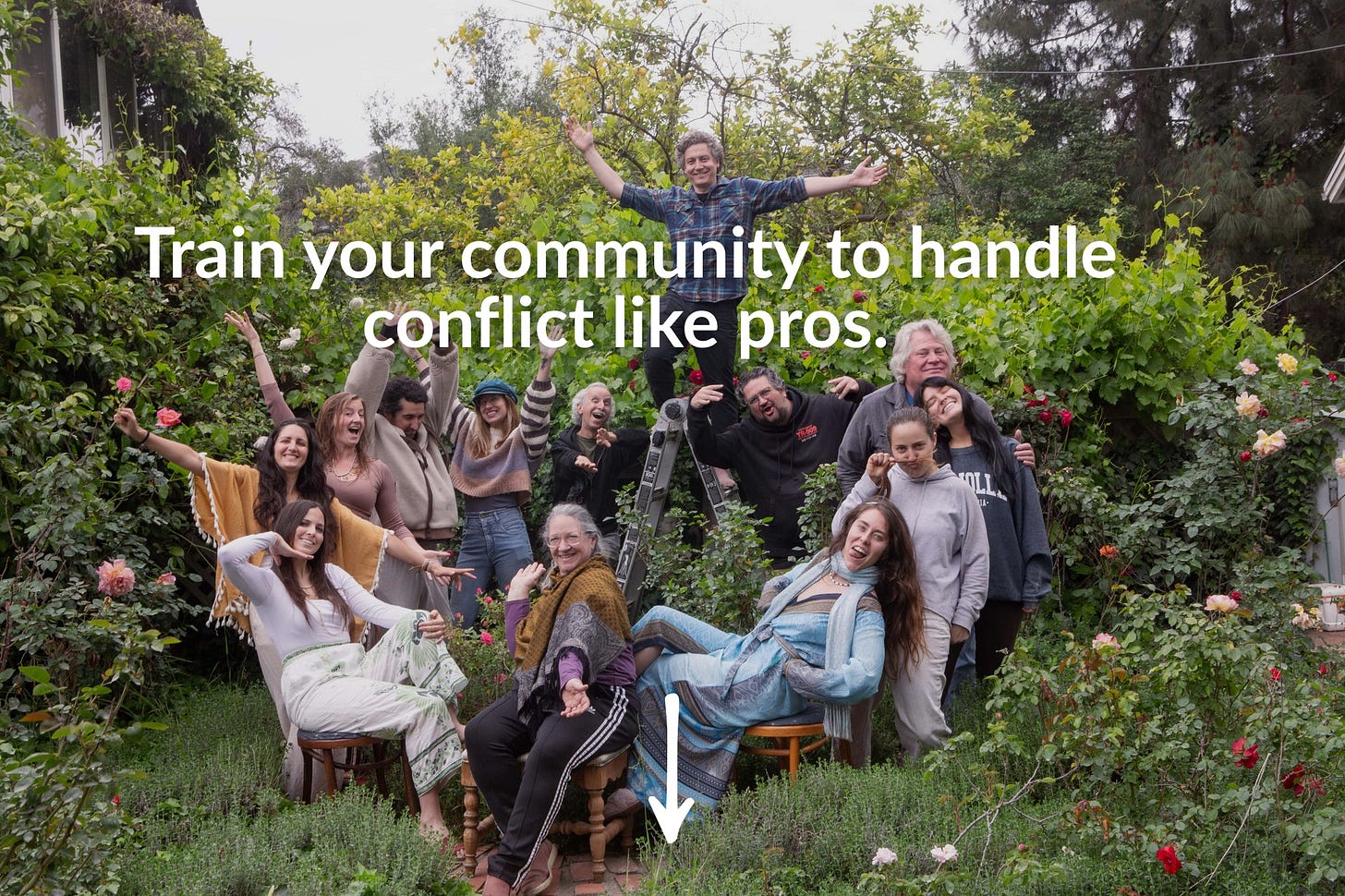The Difference Between an Ecovillage and a Regenerative Village
It's time we understood.
Two weeks ago,
asked me on the Climate Levers podcast this question, and I was annoyed that I hadn’t thought about it enough yet to articulate the differences properly. Well, I’ve thought about it.It’s time we understood the difference, because “ecovillage” and “regenerative village” each represent different iterations of the same concept.
On the surface, ecovillages and regenerative villages look very similar.
Both are ecologically-designed communities organizing around common values and holistic lifestyles. The distinction is more a 'difference in degree' than a 'difference in kind'.
So why is it important to understand the differences?
The terms represent different generation’s response to environmental destruction and a dissociative way of life
The connotations will be different for each word, and we should be aware of the associations and expectations that come with each
They loosely represent different methodologies and features
I find it helpful to think of the differences in layers.

Disclaimer: These are gross categorizations. What is mentioned is not universally true for either, and many communities will fall somewhere in the middle of the axis.
Land
For me, everything starts with the relationship to and treatment of the land.
Ecovillage
Most ecovillages stem from a dream of living “closer to the land”. The approach I’ve noticed with a good handful of them involves buying virgin land, clearing space, and building eco-friendly infrastructure.
Ecovillages are almost always rural, because being immersed in nature is a priority. Ecovillagers tend to have a strong spiritual connection with the natural world.
Regenerative Village
To be considered a regenerative village, the land in question must be ecologically degraded, have experienced biodiversity loss, or in other ways is not rich and fertile already.
Land is acquired with the intent to restore it using regenerative practices and to first and foremost understand the complexity of the ecosystem.
This also applies for urban/neighborhood scale projects.

Physical Infrastructure
At
we always go back to these pillars of self-sufficiency: food, water, energy, and waste.Ecovillage
An ecovillage may or may not prioritize self-sufficiency. Often due to the constraints of more bootstrapped budgets, there will be some ecological infrastructure — gardens, solar panels, onsite recycling practices — but I don’t typically see ambitious projects.
Obviously there are exceptions. Take Tamera’s water retention and electricity system for example.
Regenerative Village
I would generally say that the base focus of regenerative villages is on the circularity of the infrastructure and innovating to completely minimize waste and optimize systems.
For the reason that it’s much more difficult to retrofit systems that are not circular than to start with that level of resilience.


For example, an ecovillage might cover some of the resilient systems possible, but not be a fully integrated, regenerative village or “smart hood”.
Since I met
from Smart Hoods at Regen Week and understood better the thought leadership they have in the field, I’ve been vibing with their resilient engineering solutions so hard. With permission, these graphics come from their website
Built Environment
Standards of designing and building architecture in each community can be equated to sustainability vs regeneration. Sustainable architecture limits use of resources, while regeneration replenishes them.
Ecovillage
Most ecovillages I’ve seen have a low-tech building approach. Historically, houses and buildings are constructed by the founders or the owners themselves, resulting in unique places.
You might see more artisan earthships and cob houses, custom organic architecture, and DIY building.
Ecovillage founders typically act as the land developer, architect, project manager, and gardener all-in-one to meet their grassroots needs.
Regenerative Village
Regenerative architecture involves designing, sourcing, treating, and building materials to be fully circular. Then the task is also to replenish the resources used, including the human resources that make the building possible.
As stated in this article on regenerative architecture by
inThe Machuca Elements, the design is for “evolution, not obsolescence”.In my experience, [architectural] expertise is often outsourced in a regenerative village. The desire is to innovate and push the boundaries beyond our default methods, which calls on the talents of specialists in the built environment.

Social Systems
These systems are the ways that the community members relate to and meet each member’s needs. While this would also normally cover everything from governance, justice, medicine, and so on, that would be too involved to cover here. I focus on the main difference— diversity.
Ecovillage
Ecovillages are intentional communities that highly favor like-mindedness. They will form around a particular diet, spiritual practice, occupation, or worldview.
To preserve the integrity of the intention, these communities have a strong membrane for who and what comes into their community, and this keeps their community healthy and functioning according to its original values.
Regenerative Village
Regenerative villages reflect more the reality of society and its diversity. The real magic trick we want to perfect is not just living with people you like and agree with (neotribalism), but learning to coexist with everyone.
Diversity is a challenge for both types of communities, but I think regenerative village projects are much more aware of holistic approaches to positive social impact, and take active steps to address topics of gentrification and neocolonialism.

Digital Infrastructure (Technology)
Lastly, the cloud layer of technology.
Ecovillage
For the most part, ecovillages I have observed prefer the natural world over the digital one. This translates to minimizing the use of technology.
In this mindset, it’s okay to sacrifice comfort or convenience to uphold ecologically upright standards, which is actually quite noble. After all, low-tech solutions can be extremely elegant.
Regenerative Village
Regen villages are definitely tech-friendly, if not tech-driven.
They choose to incorporate more tech in order to create solutions that reach circularity while preserving modern comfort. Although, some would argue this may be impossible, such as certain advocates of #degrowth.
The emphasis is on building technology that mimics nature, or that is seamlessly integrated without disturbance or over-reliance.
So Which One Do I Use?
I don’t consider these hard and fast rules. A good chunk of people feel that the difference isn’t clear enough to merit distinguishing them. I do.
Even still, I sometimes use the words interchangeably, or modify ‘ecovillage’ to ‘modern ecovillage’.
Words are words. This is how I use them.
I am (not) the rebellious youth
Throughout this article, you might notice a slight bias towards regenerative villages.
Daniel Christian Wahl, after reading one of my articles, cautioned that I shouldn’t forget all of the wisdom that has been accrued by early pioneers of the ecovillage movement.
All of the work they have done to pave the way and create tools now supports us to create the next wave of intentional communities.
I would hope that this article, and all of my work, doesn’t come across as throwing the elders in the trashcan.
On my own journey, I hope to respect and honor the work done prior, and I aim to build on top of it — because let’s be honest, there are still a lot of gaps to fill.
Want to train your community to navigate conflict?
I just developed a 7-session training perfect for communities and colivings.
🌿270-page PDF presentation
🌿 7 workshop sessions that last ~90 minutes
🌿Group prompts, pair activities, and role play exercises
You’ll be able to teach your community how to listen deeply, communicate when it feels sticky, and grow stronger together.




We have dozens of ecovillages in Ukraine that were created on the basis of depleted farm fields (our network is about 55 locations)
and in 15 years, man-made ecosystems on 50 hectares with permaculture and Holzer lakes have grown there
Yes, I agree about the architecture, it's old-school adobe and straw bale handmade
but a large share of autonomy and self-sufficiency
also a large share of ecovillages based on restored old village houses
a lot of low-tech water waste management and infrastructure
but what I read in the OASA whitepaper is 5% of the land for infrastructure and the rest of the land for regeneration and restoration - this is actually what is done by the hands of these people and it is a lot of intellectual work as well
yes, of course, digital technologies ReFi DAO blockchain platform carbon credits, decentralized green bonds and open forest protocol
Give us a year and we will pull it up, we have a digitized nation, an intern iPhone in every pair of hands
We won't become pure open source communities, but we may take a decent mixed place between digital and hippie ecovillages somewhere
Translated with DeepL.com (free version)
Thanks for this excellent article, Nicole. I also appreciate the shout out for the podcast.
You’ve once again shown the clarity and nuance of your thinking.
Your distinctions between ecovillages and regenerative communities are truly helpful, and I appreciate that they are not dogmatic.
Everyone on this path is learning, and I value how much you share.